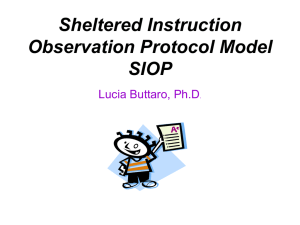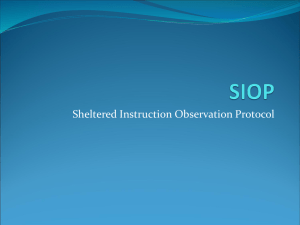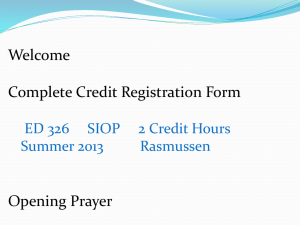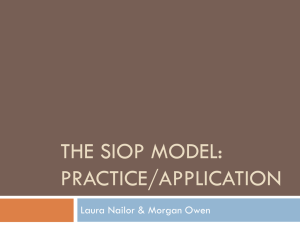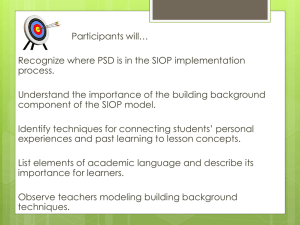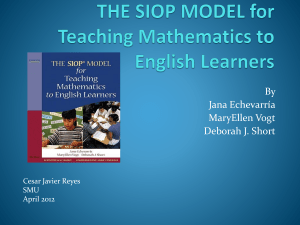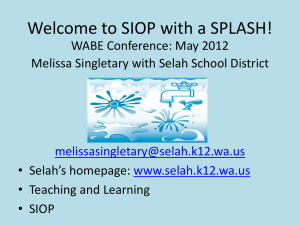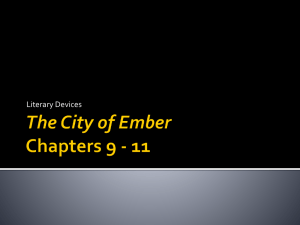SIOP PowerPoint Presentation - Juan D. Salinas Middle School
advertisement
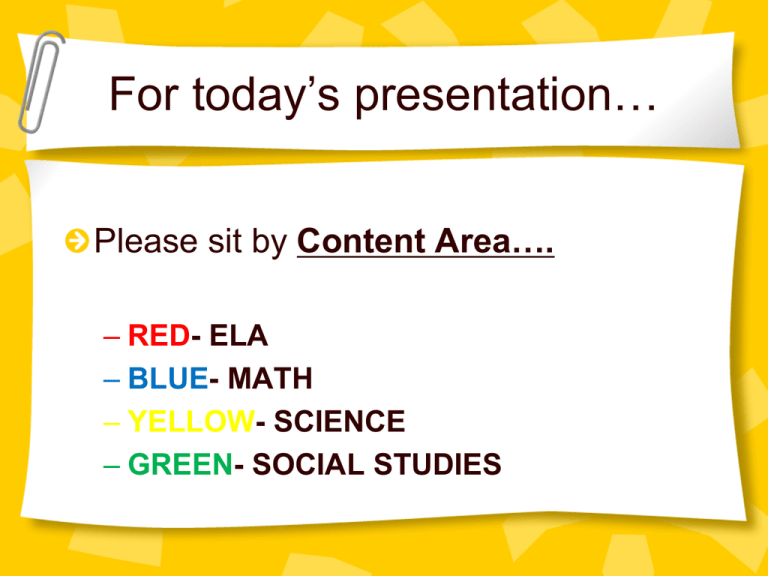
For today’s presentation… Please sit by Content Area…. – RED- ELA – BLUE- MATH – YELLOW- SCIENCE – GREEN- SOCIAL STUDIES SIOP Component 1 JD Salinas Middle School Maria Chavez ESL Specialist Presentation Norms: 1. 2. 3. 4. 5. 6. Begin and end all segments on time Keep “side bar” conversations to a minimum One speaker at a time Silence all cell phones House keeping rules Wait to be dismissed Content Objectives: I will identify the first component of SIOP and the six features of this component. Language Objectives: I will read examples of content and language objectives and write one of each. Using a brace map, I will write notes on each feature of Lesson Preparation. I will listen to a description of each feature under lesson preparation and give an oral description to my shoulder partner. Sheltered Instructional Observation Protocol S.I.O.P. – 8 Components, 30 Features Lesson Preparation Building Background Comprehensible Input Strategies Interaction Practice/Application Lesson Delivery Review/Assessment 1. Content Objectives clearly defined, displayed, and reviewed with students. 2. Language Objectives clearly defined, displayed, and reviewed with students. 3. Content concepts appropriate for age and educational background level of students. 4. Supplementary materials used to a high degree, making the lesson clear and meaningful. 5. Adaptation of content (e.g. text, assignment) to all levels of student proficiency. 6. Meaningful activities that intergrade lesson concepts (e.g. interviews, letter writing, simulations, models) with language practice opportunities for reading, writing, listening, and/or speaking. Brace Map Using a Brace Map, identify and describe the key features that make up the first component of the SIOP model. Lesson Preparation The features under Lesson Preparation initiate the lesson planning process, so we must include content and language objectives, use supplementary materials, and create meaningful activities. Learning Objectives are Essential (Both Content and Language) 1. They guide both teaching and learning in a classroom. 2. They are the foundation of a lesson. 3. SIOP classrooms have both content and language learning goals. 4. They should be written in student friendly language, posted and reviewed with students. 5. Attainment of the objectives should be assessed and reviewed with the students at the end of the lesson. Content & Language Objectives Content Objective • Concrete, identifies what students should know and be able to do. • CO must guide teaching and learning Language Objective • Identify how the students will practice their Listening, Speaking, Reading, Writing • Intentional Students learn more effectively when they know what they are supposed to be learning and why. Teachers also teach more effectively when they have the same information. Content Objectives: Statements that identify what students should know and be able to do in a particular content area. Observable and Measureable: Use active verbs in objectives that can be observed and measured. The teacher can readily assess and measure the degree to which each student has met the objective. The content objective correlates with the TEKS but should be paraphrased so that students can understand them. The exact objective or number is not acceptable. “Most of us learned the importance of writing and teaching to content objectives early In our professional preparation. However, it is often easy to overlook sharing the objectives, orally and in writing, with students.” Examples of content objectives: • I will solve word problems using a two-step process. • I will determine an author’s purpose for writing a text. • I will identify the parts of a plant. Commonly used verbs for content objectives: The students will be able to: Identify Solve Investigate Distinguish Hypothesize Create Select Draw conclusions Analyze The reason for having a language objective is to support students’ academic language development. Language objectives are simply about which domain of language you will target with your students: listening, reading, speaking, or writing. Language objectives: Statements that identify what students should know and be able to do while using English. They support students’ language development, vocabulary knowledge, functional language, language processes, and academic language growth. Observable and Measureable: Use active verbs in objectives that can be observed and measured. The teacher can readily assess and measure the degree to which each student has met the objective. The language objective correlates with the ELPS but should be paraphrased so that students can understand them. The exact objective or number is not acceptable. Language objectives may focus on developing: •Academic vocabulary •Phonemic awareness •Reading comprehension skills •A student’s ability to brainstorm, draft, revise and edit a text. •Functional language (such as presenting opinions, requesting information, negotiating meaning, providing detailed explanations.) Language objectives may focus on developing: •Higher order thinking skills (articulating predictions, stating conclusions, summarizing information, making comparisons) •Knowledge of specific grammar points (capitalization, pronoun usage, past or future verb tenses) •Knowledge of English language structures (questioning patterns, sentence formation, comparative phrases) Since acquiring a language is a process, your language objectives may range from processoriented to performance-oriented statements. This ensures that the students will have an opportunity to explore and practice an objective before demonstrating their mastery of it. Here is a progression of process-to-performance objectives that might be taught over a week. Students will be able to: Day 1 - Recognize similes in a text. Day 2 - Discuss the functions of similes. Day 3 - Write three similes. Day 4 - Write a paragraph that describes a setting using similes. Examples of language objectives: • I will write a word problem for a classmate requiring a two-step process. • I will use comparative phrases such as greater than, larger than, smaller than, and equal to orally and in writing when describing geometric figures and angles. Commonly used verbs for language objectives: The students will be able to: Listen for Retell Define Find the main idea Compare Summarize Rehearse Persuade Write Your turn… Think of a lesson that you are going to teach next week. Write a content objective and language objective for the lesson. •Turn and talk to your elbow partner. •Beach ball share out. Checklist to evaluate your content and language objectives: _____ The objectives are observable. _____ The objectives are written and presented in language the student can understand. _____ The content objective is related to the key concept of the lesson. _____ The language objective promotes student academic language growth (it is not something that most students already do well) _____The language objective connects clearly with the lesson topic or lesson activities _____I have a plan for assessing student progress on meeting these objectives during the lesson 3. Content Concepts are Appropriate for Age and Educational Background SIOP classrooms ensure that even when lesson materials may need to be adapted to meet the needs of English learners, the content is never diminished. While content is not diminished, lessons must be planned considering your students’… • • • • • first language (L1) English language proficiency Background knowledge of the topic Cultural and age appropriateness of instructional materials, and Difficulty level of any text or other material to be read. 4. Supplementary Materials used to make the lesson clear and meaningful. SIOP classrooms engage students by contextualizing their learning with the use of supplementary materials that support the curriculum. The use of planned supplementary materials enhances meaning, clarifies confusing concepts and makes lessons more relevant to the students’ lives. 4. Supplementary Materials used to make the lesson clear and meaningful. Hands-on manipulatives - cubes, counter chips Realia – any real-life objects that pertain to the lesson Pictures – Google Image is a great resource Visuals - graphs, charts, timelines, props Multimedia - DVDs, learn360 video clips, tape recordings Demonstrations - modeling how to use the materials Related Literature - fiction and nonfiction picture books Hi-Lo Readers - books that are high interest but lower readability level. Adapted Text – rewriting text so that it is at a lower readability level Example of Adapted Text Social Studies Chapter: 24 pages Adapted Text: 6 pages 5. Adaptation of content to all levels of student proficiency Often teachers are required to teach from a textbook that is too difficult for English learners. We also know that ELLs cannot be expected to learn all content information by listening to lectures. Therefore, we must find ways to make the text and other resource materials accessible for all students, adapting them so that the content concepts are left intact. The following techniques can be used as a pre-reading instructional strategy, as an aid during the reading, or as a post-reading method for organizing new information Graphic organizers Outlines Leveled Study Guides Highlighted Text Adapted Text Jigsaw Text Reading Marginal Notes Native Language Texts Examples Venn Diagrams Timelines Comparison Charts 6. Meaningful activities that integrate lesson concepts with language practice Students need opportunities to practice their oral and written language skills in a context that is relevant to the lesson concepts. Providing ELLs with authentic, meaningful experiences is especially important because it allows for their learning to become concrete instead of abstract. Three Foundational, Research-Based Issues in ELL Instruction Issues to Guide our Instruction for ELL Academic Success Presented by Marcia Gaudet • ELL Instructional Coach I Review – Lesson Preparation Content Objectives Clearly Defined, Displayed and Reviewed with Students Language Objectives Clearly Defined, Displayed and Reviewed with Students Content Concepts Appropriate for Age and Educational Background Supplementary Materials Used to a High Degree Adaptation of Content to All Levels of Student Proficiency Meaningful Activities That Integrate Lesson Concepts with Language Practice Opportunities Did we meet our objectives? Content Objectives: I will identify the first component of SIOP and the six features of this component. Language Objectives: I will read examples of content and language objectives and write one of each. Using a brace map, I will write notes on each feature of Lesson Preparation. I will listen to a description of each feature under lesson preparation and give an oral description to my shoulder partner. Questions? Lesson preparation is important because we know that thoughtful planning with consideration of your students individual needs, leads to FOCUSED and effective teaching and learning! Ticket Out - Additional questions and comments.
